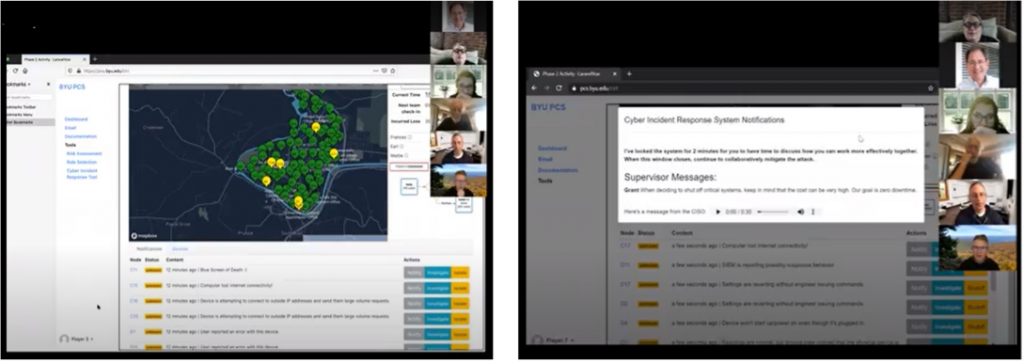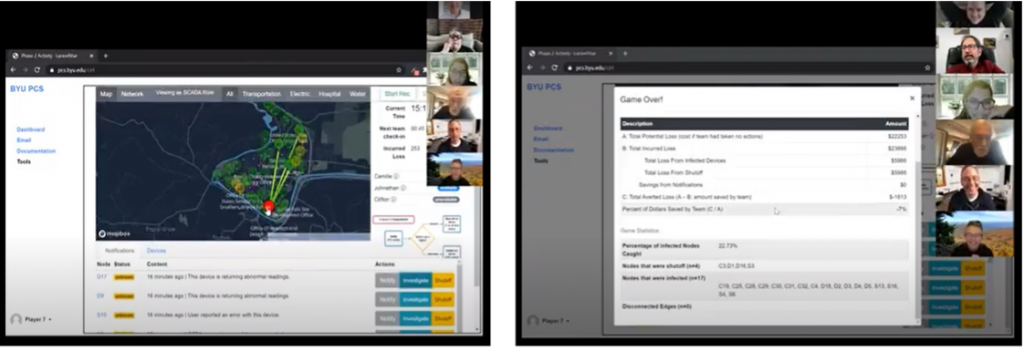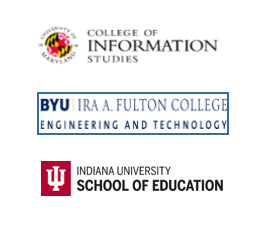Progress with Both Narratives
December saw our project working with both of the narrative versions originally proposed. The first narrative for Cybersecurity had run a pilot in a fall course and conducted a meaningful test with the Advisory Board on December 7. The second narrative involving Disaster Response began to formalize a design that uses the phase structure and some of the pre/post testing of the Cybersecurity module with a game mechanic that involves players solving different cases in the fictional community of Bronze Falls.
Cybersecurity: Advisory Board Playtest
In mid-December, the advisory board assembled in virtual rooms hosted on Zoom to playtest the cybersecurity playable case study (PCS). The goal was to have the advisory board play through Phases 0-3, Introduction, Role Selection, Risk Assessment, Cyberattack, and Attribution. In addition to playtesting the technology architecture, the advisory board members got a first-hand experience of the narrative arc of the PCS, which plays out with the help of communication messages with NPCs or non-player characters, activities that scaffold understanding of STEM roles for students, and the cybersecurity crisis. We were fortunate to have Richard Duschl, Yasmin Kafai, Z Toups, Rebecca Quintana, Lei Liu, and Bob Dolan participate in the playtest.

Figure 1 – Advisory Board playtest early in the cyber-attack
The playtest foregrounded the idea of human-centered cybersecurity where the connections between the cybersecurity issues and the human who created them are made apparent. This was achieved through the in-game messaging that gave voice to the “villain” who was threatening the integrity of the city’s cybersecurity systems.
During the playtest, we captured all communication by the playtesters and encouraged them to think-aloud as they played the game. This exercise provided valuable insights into the intricacies of the gameplay that need to be tweaked. The major themes that emerged from later analysis of the communication are related to: (a) better enunciation of the learning goals through the phases, (b) timing from both a narrative and gameplay perspective that would give time for collaboration, (c) bridging the phases in a seamless and meaningful manner such that choices in one phase have direct connections with actions in the next phase.

Figure 2 – Playtest during the attack
The team also faced the challenge of compressing an experience that is designed to be several weeks long into a matter of hours for the playtest. We are thinking of innovative solutions to this problem as it will be something we will have to deal within all future playtests.
Visualizing Collaborative Writing Practices
Writing in teams in cloud-based environments rests on effective communication and collaboration. Collaborative writing using platforms such as Google Docs has become a commonplace practice in professional settings. Yet, this form of writing has yet to find its rightful place in academic training. To address this gap, the Careers in Play project is building a module within the Playable Case Study (PCS) where students will compose documents in teams. We will provide them with formative feedback that should serve as a starting point for self-reflection.

Figure 2. Visualizing Collaborative Writing Practices
As a first step, we have formed a multidisciplinary team of students specializing in visual design, computer science, and educational psychology to create prototypes of effective visualization that capture the process of collaborative writing and provide actionable insights for students and educators, and data to researchers. The different forms of visualizations and their role in a learning analytics design is the topic of a poster proposal submitted to the International Conference on Learning Analytics and Knowledge.
Team Member Spotlight: Aatish Neupane
Namaste! I am currently a Masters in Information Technology at Brigham Young University. I joined BYU in the Fall of 2019 and I am hoping to graduate in April 2021. I joined the CIP project under the supervision of Dr. Hansen in the Winter of 2020. Since then, I have helped with different aspects of design and development for the cybersecurity simulation some of which include Risk Assessment and Phase 2 Activity. Currently, I am involved in creating a collaborative editor for the Phase 3 Activity. I was born and raised in Nepal under the shadows of the Himalayas. As a result, I generally like being outdoors. I have a personal passion for healthcare technologies and improving access to healthcare through public health interventions. I hope to join a good PhD program in these areas and build a professional career around it.

Figure 3. Aatish Neuapane
Careers In Play Leadership Team
Phil Piety, PhD. University of Maryland iSchool (PI and Learning Analytics). ppiety@umd.edu
Beth Bonsignore PhD. University of Maryland iSchool (Co-PI and Design-based Research), ebonsign@umd.edu
Derek Hansen, PhD.Brigham Young University (Co-PI and Game Technology). dlhansen@byu.edu
Dan Hickey, PhD. Indiana University School of Education (Co-PI, Learning Theory and Assessments). dthickey@umd.edu
